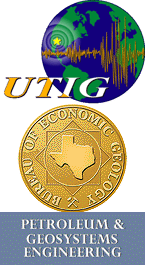University of Texas at Austin Receives $1 Million To Build Carbon Capture and Storage Workforce
September 8, 2009

The University of Texas at Austin will use a $994,702 grant from the U.S. Department of Energy to help create a skilled workforce for the emerging carbon capture and storage industry and to build public awareness of the technology’s benefits to society.
Carbon capture and storage (CCS) is a process that captures the greenhouse gas carbon dioxide from the burning of fossil fuels at power plants and pipes it deep underground in places that have suitable properties to contain the gas. Proponents of CCS say the process will make it possible to continue to use domestic coal for electric power while simultaneously reducing greenhouse gas emissions. Congress is considering legislation that would effectively put a price on carbon emissions, providing an economic incentive for CCS.
The three-year grant is part of $8.4 million the Department of Energy recently awarded to support training and education in the CCS field as part of President Barack Obama’s economic stimulus plan.
The university’s allocation enables the creation of the Alliance for Sequestration Training, Outreach, Research and Education (STORE), which draws together researchers and educators from three units within the university: the Institute for Geophysics, the Center for Petroleum and Geosystems Engineering, and the Bureau of Economic Geology.
Hilary Olson, project director and co-principal investigator for the STORE Alliance at the Institute for Geophysics, notes that balancing the nation’s energy needs with its stance on controlling greenhouse gases necessitates ramping up the CCS effort, particularly in the Gulf Coast states of Texas, Louisiana and Florida—STORE Alliance’s target states, which are all among the top 10 carbon dioxide (CO2) emitters in the country.
“Our STORE Alliance is designed to accelerate the transfer of scientific knowledge and applied engineering technologies to create both a skilled workforce and better public awareness of the emerging CO2 sequestration industry and technology in America,” said Olson. “Our training will take a multi-tiered approach, targeting professionals, university professors and students, pre-university teachers and the general public.”
Associate Professor Steven Bryant notes the Department of Petroleum and Geosystems Engineering, which houses one of the leading research groups in geologic carbon sequestration, educates 15 percent of the undergraduates in petroleum engineering in the U.S., making it well-suited to help lead the effort in this new workforce training.
“The very same skills these students are taking to the hydrocarbon production industry are also needed to design, construct and operate geologic sequestration,” said Bryant, who is the project’s lead principal investigator. “This is why one of the biggest hurdles to implementing this key method of mitigating carbon emissions is not technical or financial or legal—it’s having enough people with the relevant skills in place to do the work. This project is a big step toward clearing that hurdle. ”
The Bureau of Economic Geology, through its Gulf Coast Carbon Center, has a wealth of technical experience from years of conducting carbon storage experiments. The bureau has received more funding for CCS research than any other academic unit in the country and is conducting a $34 million, multi-year field study of carbon storage and monitoring strategies in southwest Mississippi.
“We have already completed four field tests of geologic carbon storage and we have one major one underway,” said Sue Hovorka, principal investigator for the Bureau’s Gulf Coast Carbon Center and co-principal investigator for the STORE Alliance. “We also have nine more proposed projects across the southern and western U.S. awaiting funding. Few institutions have this kind of experience. That helps engage the public and decision makers and helps us provide important skills to students and workers.”
The Institute for Geophysics adds to this technical base a strong education, training and outreach component. Other participants in STORE include Striker Communications and Sandia Technologies.
For more information about research at the Jackson School, contact J.B. Bird at jbird@jsg.utexas.edu, 512-232-9623.
